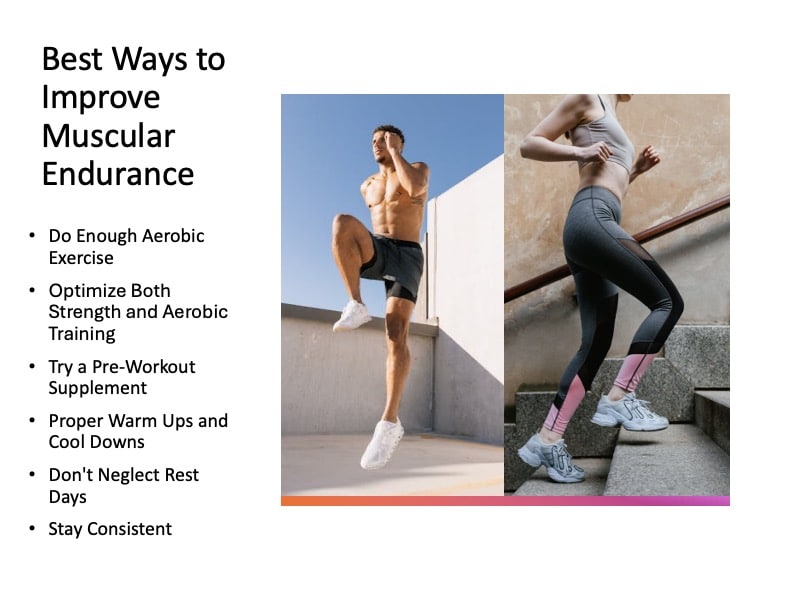How to Improve Muscular Endurance & Stamina
To improve muscular endurance, you need a consistent training approach that targets both strength and stamina over time.
Muscular endurance is the ability of your muscles to sustain repeated contractions or maintain force against resistance for extended periods.
It’s what allows you to push through long workouts, maintain proper form under fatigue, and perform daily tasks without tiring quickly.
Whether you’re an athlete aiming for better performance, a gym-goer looking to complete high-rep sets more efficiently, or someone who simply wants greater physical resilience, focusing on ways to improve muscular endurance can transform your fitness.
This includes targeted strength training, aerobic conditioning, proper recovery, and strategic use of muscular endurance-focused exercises that gradually increase your time under tension and work capacity.
What is Muscular Endurance?
Muscular endurance is the ability of a muscle or group of muscles to perform repetitive contractions against resistance for an extended period without becoming fatigued.
Unlike maximal strength, which measures how much force you can exert in a single effort, muscular endurance is about how long your muscles can keep working under stress.
Think of performing a 20-rep squat workout, holding a plank for 90 seconds, or doing a high-rep set of push-ups.
These are all tests of muscular endurance.
Muscular endurance plays a vital role in both athletic performance and everyday function.
Whether you’re hiking up a steep trail, carrying groceries up several flights of stairs, or grinding through the fourth quarter of a game, your ability to keep going without your muscles giving out depends on muscular endurance.
This trait is especially important for athletes, military personnel, and anyone involved in physically demanding jobs or activities.
Training to improve muscular endurance typically involves moderate to high reps with lower weights, minimal rest between sets, and consistent time-under-tension strategies to build fatigue resistance over time.
Endurance vs Stamina: What’s the Difference?
Although often used interchangeably, endurance and stamina refer to different aspects of physical performance—and understanding the distinction can help you train more effectively.
- Endurance refers to your body’s ability to sustain prolonged physical activity over time. It’s divided into two components: cardiovascular endurance (how well your heart and lungs deliver oxygen during long sessions of aerobic exercise) and muscular endurance (how long your muscles can perform repeated contractions under stress). If you’re looking to run a marathon, cycle long distances, or complete high-rep strength circuits, endurance is the quality you’re aiming to develop.
- Stamina, on the other hand, reflects your overall energy and mental resilience. It’s the feeling of being able to push harder, longer, and with more vigor—especially during shorter, more intense efforts. Stamina is about sustaining high performance output and maintaining focus, even when your body starts to fatigue.
To simplify:
- Endurance = duration of performance
- Stamina = intensity + drive to sustain effort
Improving one often improves the other, but your training should align with your goals.
For longer workouts or sports that demand lasting effort, focus on how to improve endurance.
For shorter, high-output performances (like sprints or fast-paced circuits), stamina-building strategies will be more important.
Best Ways to Improve Muscular Endurance

Building muscular endurance is essential for anyone who wants to move better, perform longer, and feel stronger throughout daily life or athletic activity.
Whether you’re a beginner looking to increase your work capacity or an experienced athlete aiming to push through fatigue during high-rep sets or long training sessions, improving muscular endurance will help you perform at your best.
The strategies below focus on progressive overload, proper movement patterns, and smart programming, which help you develop muscles that don’t just look strong but stay strong under pressure.
Do Enough Aerobic Exercise

One of the most effective ways to improve muscular endurance is by incorporating regular aerobic exercise into your routine.
If you’re already doing cardio workouts, try switching up the type or intensity.
Incorporating metabolic conditioning workouts, which are short, intense circuits that challenge both your aerobic and anaerobic systems, can significantly boost endurance and accelerate fat loss.
Key Point: Variety is especially helpful if you’ve hit a plateau and can’t seem to make further gains. Changing your aerobic stimulus keeps the body adapting and progressing.
If you’re new to aerobic training, start with 20–30 minutes per day of low-impact activities like walking, cycling, or swimming.
The key is consistency and gradual progression, as pushing too hard too soon can lead to burnout or injury, while a steady build allows your cardiovascular system to grow stronger over time.
Optimize Both Strength and Aerobic Training
To improve muscular endurance, combining both strength and endurance strategies, also known as concurrent training, can lead to powerful physiological adaptations when properly programmed.
Research shows that skeletal muscle adapts to different exercise stimuli by altering mitochondrial content, contractile proteins, and neuromuscular signaling, depending on the intensity, frequency, and type of training used (Hughes et al., 2018).
Classic endurance training improves oxygen transport and mitochondrial biogenesis, while strength training boosts muscle cross-sectional area and force output.
When combined strategically, both systems can develop simultaneously to increase fatigue resistance without sacrificing strength.
However, if training volume is too high, concurrent training may impair gains in maximal strength or size, so balance is key.
For example, high-intensity interval training (HIIT) has been shown to increase mitochondrial respiration and energy production efficiency, supporting long-duration muscular work.
This makes it an efficient complement to resistance training when muscular endurance is the goal.
Fuel and Refuel with Proper Nutrition

Nutrition plays a critical role in your ability to improve muscular endurance and recover efficiently between workouts.
Without the right fuel, your muscles fatigue faster, your performance drops, and your adaptations stall.
Before training, focus on a meal or snack that provides easily digestible carbohydrates and a moderate amount of protein.
This helps top off glycogen stores and supports muscle function during prolonged or high-rep sessions.
Consuming carbohydrates before training has been shown to improve both exercise capacity and overall performance, particularly in workouts lasting over 60 minutes.
Options like oatmeal with fruit, a banana with almond butter, or a simple protein shake with some carbs can be effective.
After your workout, your priority should shift to refueling and repairing.
Consuming protein with carbohydrates within 30–60 minutes post-exercise promotes muscle protein synthesis and replenishes depleted glycogen.
Aim for 20–30 grams of high-quality protein and a moderate amount of carbs, such as a smoothie with whey protein and berries or grilled chicken with rice.
Staying hydrated and supporting your micronutrient needs, especially with magnesium, potassium, sodium, and calcium, also ensures optimal muscle function and energy production.
Consistent, strategic nutrition not only improves endurance but also reduces fatigue and accelerates long-term progress.
Try a Pre-Workout Supplement
Pre-workout supplements are one of the most widely used supplements because they can increase energy, focus, and physical output before training begins.
Most formulas contain a blend of caffeine, electrolytes, amino acids (such as beta-alanine or citrulline malate), creatine monohydrate, and other supplements for athletic performance designed to improve blood flow, reduce fatigue, and sharpen mental clarity.
However, not all pre-workouts are created equal.
Choose a product with clean, research-backed ingredients and avoid excessive artificial fillers or stimulants that can lead to energy crashes or digestive discomfort.
For those looking to push through physical and mental plateaus, a well-formulated pre-workout can be a powerful tool.
To maximize your muscular endurance and training potential, consider pairing it with an intra-workout drink, which helps sustain hydration, performance, and muscular endurance during extended or high-intensity sessions.
Proper Warm Ups and Cool Downs
A proper warm-up and cool-down aren’t just optional, they’re essential for performance, injury prevention, and recovery.
If your goal is to improve endurance, how you prepare and recover can significantly impact how well your body adapts to training.
Start each session with a dynamic warm-up that includes movements like leg swings, arm circles, walking lunges, or jumping jacks.
These exercises elevate your heart rate, activate key muscle groups, and improve joint mobility, priming your body for cardio and resistance-based endurance work.
Dynamic stretching in this phase helps increase range of motion and reduce the risk of muscle strain.
Equally important is how you finish your workout.
A good cool-down helps lower your heart rate gradually and begins the recovery process.
Focus on static stretching for major muscle groups and add foam rolling to relieve tight areas, improve circulation, and recover faster after exercise.
These strategies can reduce delayed-onset muscle soreness (DOMS) and keep your body moving efficiently for the next workout.
Don’t Neglect Rest Days
If improved muscular endurance is the goal, then you need to pay attention to your rest days to enable you to deliver the performances you need.
Pushing your body to the limit won’t make you better; it will injure you and hinder your abilities.
Treat rest days as you would exercise days and schedule them so you don’t push your body too hard and end up causing damage.
Ideally, you don’t want to workout for more than two consecutive days without a rest.
Even if it’s an active rest day, doing gentle mobilitty exercises or a swim allows your body to move at a more gentle pace to facilitate recovery and give you the energy to meet your goals for your next workout.
Stay Consistent
When it comes to improving muscular endurance, consistency is everything.
You don’t need to train at maximum intensity every day, but you do need to show up regularly.
Progress comes from committing to your workouts, staying mindful of your nutrition, honoring rest days, and supporting your overall health week after week.
Muscular endurance is built gradually through repetition and smart effort.
Even small, consistent actions compound over time.
Stay focused, trust the process, and you’ll find that your capacity to push farther and perform better grows steadily with each disciplined day.
Final Thoughts: Keys to Improving Muscular Endurance

Improving muscular endurance isn’t about one single workout, it’s about layering together smart training, proper recovery, and long-term consistency.
The most effective approach combines resistance training, aerobic conditioning, and adequate rest, with progression based on your current fitness level and goals.
Incorporate metabolic conditioning circuits, vary your aerobic activity, and support your sessions with targeted supplements for athletic performance when needed.
Don’t overlook warm-ups, cool-downs, and intra-workout hydration strategies, which all play a role in building muscular resilience.
Stay consistent, listen to your body, and challenge your limits gradually.
Over time, you’ll build the kind of endurance that allows you to move longer, recover faster, and perform better, both in the gym and in life.



